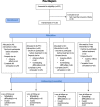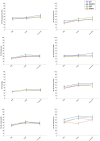Active and sham transcranial direct current stimulation (tDCS) improved quality of life in female patients with fibromyalgia
- PMID: 35229253
- PMCID: PMC9250466
- DOI: 10.1007/s11136-022-03106-1
Active and sham transcranial direct current stimulation (tDCS) improved quality of life in female patients with fibromyalgia
Erratum in
-
Correction to: Active and sham transcranial direct current stimulation (tDCS) improved quality of life in female patients with fibromyalgia.Qual Life Res. 2023 Oct;32(10):3001. doi: 10.1007/s11136-023-03478-y. Qual Life Res. 2023. PMID: 37488454 Free PMC article. No abstract available.
Abstract
Purpose: Fibromyalgia (FM) is a chronic pain syndrome with a strong impact on quality of life (QoL). Treatment of this condition remains a challenge, due to the scarce evidence for the effectiveness of the therapeutic approaches available. Current attention is focused on transcranial direct current stimulation (tDCS), which has yielded promising results for pain treatment. Rather than focusing only on pain relief, in this study, we aimed to determine how active or sham tDCS (over three cortical targets -the primary motor cortex, the dorsolateral prefrontal cortex and the operculo-insular cortex-) affect QoL in patients with FM.
Methods: Using a double-blind, placebo-controlled design, we applied fifteen tDCS sessions of 20' to initial 130 participants (randomized to any of the four treatment groups). We evaluated the QoL (assessed by SF-36) and the symptoms' impact (assessed by FIQ-R) in baseline, after treatment and at 6 months follow-up.
Results: All groups were comparable as regards age, medication pattern and severity of symptoms before the treatment. We found that QoL and symptoms' impact improved in all treatment groups (including the sham) and this improvement lasted for up to 6 months. However, we did not observe any group effect nor group*treatment interaction.
Conclusions: After the intervention, we observed a non-specific effect that may be due to placebo, favoured by the expectations of tDCS efficacy and psychosocial variables inherent to the intervention (daily relationship with therapists and other patients in the clinic). Therefore, active tDCS is not superior to sham stimulation in improving QoL in FM.
Keywords: FIQ-R; Fibromyalgia; Quality of life (QoL); Randomized controlled trial (RCT); SF-36; Transcranial direct current stimulation (tDCS).
© 2022. The Author(s).
Conflict of interest statement
The authors state that they do not have any competing interests.
Figures




Similar articles
-
Effects of Anodal Transcranial Direct Current Stimulation on the Primary Motor Cortex in Women With Fibromyalgia: A Randomized, Triple-Blind Clinical Trial.Neuromodulation. 2023 Jun;26(4):767-777. doi: 10.1016/j.neurom.2022.11.007. Epub 2023 Jan 25. Neuromodulation. 2023. PMID: 36702675 Clinical Trial.
-
Transcranial direct current stimulation of 3 cortical targets is no more effective than placebo as treatment for fibromyalgia: a double-blind sham-controlled clinical trial.Pain. 2022 Jul 1;163(7):e850-e861. doi: 10.1097/j.pain.0000000000002493. Epub 2021 Sep 23. Pain. 2022. PMID: 34561393 Clinical Trial.
-
Optimised transcranial direct current stimulation (tDCS) for fibromyalgia-targeting the endogenous pain control system: a randomised, double-blind, factorial clinical trial protocol.BMJ Open. 2019 Oct 30;9(10):e032710. doi: 10.1136/bmjopen-2019-032710. BMJ Open. 2019. PMID: 31672712 Free PMC article.
-
Is Transcranial Direct Current Stimulation (tDCS) Effective for the Treatment of Pain in Fibromyalgia? A Systematic Review and Meta-Analysis.J Pain. 2020 Nov-Dec;21(11-12):1085-1100. doi: 10.1016/j.jpain.2020.01.003. Epub 2020 Jan 23. J Pain. 2020. PMID: 31982685
-
Efficacy and safety of transcranial direct current stimulation in the treatment of fibromyalgia: A systematic review and meta-analysis.Neurophysiol Clin. 2024 Feb;54(1):102944. doi: 10.1016/j.neucli.2024.102944. Epub 2024 Feb 21. Neurophysiol Clin. 2024. PMID: 38387108
Cited by
-
Non-Invasive Electric and Magnetic Brain Stimulation for the Treatment of Fibromyalgia.Biomedicines. 2023 Mar 20;11(3):954. doi: 10.3390/biomedicines11030954. Biomedicines. 2023. PMID: 36979932 Free PMC article. Review.
-
Effect of Single Session of Anodal M1 Transcranial Direct Current Stimulation-TDCS-On Cortical Hemodynamic Activity: A Pilot Study in Fibromyalgia.Brain Sci. 2022 Nov 18;12(11):1569. doi: 10.3390/brainsci12111569. Brain Sci. 2022. PMID: 36421893 Free PMC article.
-
Pain reduction in fibromyalgia syndrome through pairing transcranial direct current stimulation and mindfulness meditation: A randomized, double-blinded, sham-controlled pilot clinical trial.Front Med (Lausanne). 2022 Oct 12;9:908133. doi: 10.3389/fmed.2022.908133. eCollection 2022. Front Med (Lausanne). 2022. PMID: 36314032 Free PMC article.
-
Short-Term Magnesium Therapy Alleviates Moderate Stress in Patients with Fibromyalgia: A Randomized Double-Blind Clinical Trial.Nutrients. 2022 May 17;14(10):2088. doi: 10.3390/nu14102088. Nutrients. 2022. PMID: 35631229 Free PMC article. Clinical Trial.
-
Therapeutic approach to fibromyalgia: a consensus statement on pharmacological and non-pharmacological treatment from the neuropathic pain special interest group of the Italian neurological society.Neurol Sci. 2025 May;46(5):2263-2288. doi: 10.1007/s10072-025-08048-3. Epub 2025 Feb 21. Neurol Sci. 2025. PMID: 39982626 Free PMC article.
References
-
- Bartels EM, Dreyer L, Jacobsen S, Jespersen A, Bliddal H, Danneskiold-Samsøe B. Fibromyalgia, diagnosis and prevalence: Are gender differences explainable? Ugeskrift for Laeger. 2009;171(49):3588–3592. - PubMed
Publication types
MeSH terms
Grants and funding
LinkOut - more resources
Full Text Sources
Medical

